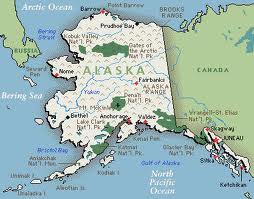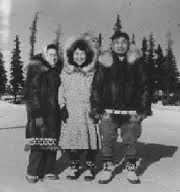It is amazing that early-comers to Alaska put financial/economic gain so far above the need for Human Services. It was rare to find schools, hospitals, medical services anywhere in Alaska. As I begin this study, I wonder how people lived without these essential services. The topic underscores the challenge of life in Alaska in the 1800s and 1900s.
Essential Question?????
 |
| Alaska's Vast Geographic Expanse (Google Image) |
A Brief History of Alaska Health Care
1800 - Church missions first to respond to AK health care needs
1867 - Coast Guard opens hospital in Sitka
1886 - Catholic hospital established in Juneau
1896 - Yukon Delta provides doctor by dog-team
1887-1917 - Eight hospitals established in AK by mission groups
Early 1900s - AK has traveling nurses to support health needs
Early 1900s - Bureau of Education provides health care in isolated villages and by medical ship (7 hospitals and one boat). Nurses stationed at 16 locations throughout the state.
1915 - 25-bed Alaska Native hospital built in Juneau
1931 - Bureau of Indian Affairs takes over health care
1943 - American Red Cross established service in Alaska
1946 - Seward sanatorium initiated
1950 - Alaska Psychiatric Institute started
1953 - 400-bed Alaska Native Hospital built in Anchorage
1961 - Remote hospitals built in Kotzebue and Barrow
Today the Alaska Department of Health and Social Services provides public health clinics throughout the state.
 |
| 1910 AK Native Territorial Hospital Juneau (Google Image) |
 |
| Holy Cross Hospital Nome (Google Images) |
 |
| St John's Episcopal Hospital 1904 (Google Image) |
 |
| Simpson Hospital Juneau 1910 |
Challenges of Providing Health Care in a vast Geographic Area
Settlement of Alaska by new arrivals has followed the multiple stages of economic development. Money (or the eagerness to get it) brought the people to Alaska, and the money either sustained their pursuits, or stopped and people moved away. People arrived and then left depending on the economy and financial gain. The times were filled with "boom" or "total loss!" The focus was first and foremost financial. Needs for social services came later as people began to stay in geographic areas. Construction of health care facilities followed settlements as they became more and more established. Most Alaskans lived in communities, although some communities were very small. The primary reason for community living was people preferred the company of others and there was safety living near others with the adversities of Alaskan life.
Early health care in Alaska was a missionary activity. Church mission groups established health care services and facilities to support the growing population in many settlements, and later in towns. It was not until the early 1900s when the Federal government began to provide these services. And it was nearly 60 years later when services were provided to the most remote locations.
As economies fizzled, health care and educational services diminished or ceased. Between 1940 and 1950, the territory's civilian population increased from 74,000 to 112,000 due to the growth of military installations. This influx put a tremendous strain on the inadequate social services in Alaska (Alaska Heritage, Chpt 4-3).
The story of Alaskan health care is connected directly to the immigration of "outsiders" to Alaska. A review of the early medical and educational services and facilities matches closely the physical landscape, infrastructure of transportation/communication, and the larger historical population centers of the state.
Brief History of Education in Alaska
1867 - Russians closed their schools when they left the territory
1868 - First school opened in Sitka
1870 - US Government requires private company to establish school for 50 students in their community
1880 - Sitka established 2 schools, one for Natives and one for non-Natives
1877 - Wrangell Mission School started
1878 - Presbyterian mission industrial school started
1881 - Navy Commander Glass requires Native children in Sitka to attend school
1884 - Congress passed law to provide education for children in AK without regard to race.
1892 - 17 government-supported schools operating. 14 of theses were for non-natives
1900 - Revised Organic Act provided for schools in incorporated Alaskan towns
1905 - Nelson Act requires education for "white children and children of mixed blood"
1905 - Catholic mission vocational training school started solely for AK Natives
1913 - AK Territorial Legislature passed law requiring all children to attend school
1915 - First AK vocational boarding school for Native youth
1931 - Bureau of Indian Affairs took over operation of rural schools and boarding schools
1947 - Mt Edgecombe opened
1976 - State of AK required by lawsuit to construct schools in rural areas
Socio-Cultural Norms of Dominant Culture
Since the beginning of educational opportunities in Alaska, the dominant culture has strived to establish education that closely matches the opportunities that existed in other US states and territories. Government was consistently inadequate in providing for early educational options, so connections were established with various church mission groups to establish schools. The schools were patterned after other private schools in the "lower 48" by using similar structures, procedures and curricula. In the mid-1880s Sheldon Jackson worked with mission boards of Protestant churches to establish educational opportunities. Essentially, the federal and state dollars went to supporting churches. The churches gained strongholds in education and continued to provide education in Alaska for decades.
 |
| AK Natives required to imitate Euro-American School model |
As education progressed, more of a "dual-system" developed, providing education to separated Native and non-native populations. Fines were imposed on Native Alaskan families for their students not attending schools.
Early education focused on traditional US School System topics of reading, composition, handwriting, math and civics. The school calendar was patterned after typical school system calendars from fall to late spring. There was often no thought to the conflict this created with Native Alaskan subsistence cycles. The children were no longer allowed to move between spring and fall hunting camps. Many students were significantly restricted from spending times with their families, and some in boarding schools did not see their families for years at a time.
The negative impact of early educational opportunities began to change when the Rural Education Attendance Areas (REAAs) were created. This was the first time that Native people felt the hint of some promise of a measure of self-determination in the educatio of their children.
 |
| Holy Cross Mission School - Yukon River 1914 (Google Image) |
 |
| Kotzebue School 1907 (Google Image) |
EXAMINE...
 Bristol Bay Campus - Tourism, International Business, Community Health, Renewable Resources, Entrepreneurship, Rural Development.
Bristol Bay Campus - Tourism, International Business, Community Health, Renewable Resources, Entrepreneurship, Rural Development.Interior/Aleutians - Construction, Rural Nutrition, Tribal Management, Rural Human Services, Veterinary Science.
Kuskokwim Campus - AK Natuve Culture, Yup'ik Language, Rural Human Service, Emergency Wilderness Training
Northwest Campus - Alternative Energy, Practical GIS for Rural AK, Birds of AK, Marine Advisory Program, High Latitude Range Management, Snowmachine maintenance, Edible/medicinal Plants.
EXTEND...
 I was able to preview a excerpts of the book, Dictionary of Alaska Place Names, by Donald Orth, 1967 and 1971. This is a truly unique book and very interesting historically. It gives names of Alaska "places" including streams, bays, valleys, mountains, points, water passages, etc. Included in the book are places that "are" and those that "once were." Each entry includes a narrative location (near the stream X) and latitude - longitude. Additionally, a bit of history is included, like how the place was names, by whom and when. Here is one sample entry: "Lost Harbor: locality, at Lost Harbor on W coast of Akun Island, Aleution Islands; (map 24). Name of a former mining camp that was located on the island in the 1920s. the camp contained a smelter, tramway, machine shop, commissary and other buildings for the operation of a sulphur mine."
I was able to preview a excerpts of the book, Dictionary of Alaska Place Names, by Donald Orth, 1967 and 1971. This is a truly unique book and very interesting historically. It gives names of Alaska "places" including streams, bays, valleys, mountains, points, water passages, etc. Included in the book are places that "are" and those that "once were." Each entry includes a narrative location (near the stream X) and latitude - longitude. Additionally, a bit of history is included, like how the place was names, by whom and when. Here is one sample entry: "Lost Harbor: locality, at Lost Harbor on W coast of Akun Island, Aleution Islands; (map 24). Name of a former mining camp that was located on the island in the 1920s. the camp contained a smelter, tramway, machine shop, commissary and other buildings for the operation of a sulphur mine."I found three used copies of this dictionary available for purchase on Amazon.com. The used copies started at $175.00.
Author Donald J. Orth wrote/compiled or co-authored several books of the same type. All were published by the Government Printing Office. Apparently he was an effective grant writer, based on his number of publications, his access to using the Government Printing Office, and his continuing royalties for a book written over 40 years ago.
EVALUATION...
I enjoyed this module. More and more I am seeing connections between population growth and other areas of economy and human services. I admire the early AK settlers and their determination for success as they moved to AK with little or no social services.
I am pleased that education of Alaskan Natives is once again returning to "its roots" of quality education that supports the cultures, languages, and learning styles of the Native children and groups. We can learn much from AK Cultural Education and their holistic and experiential approaches.





No comments:
Post a Comment